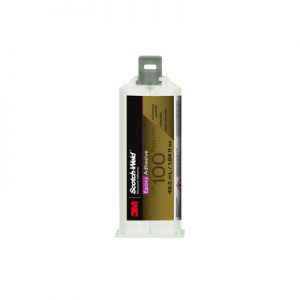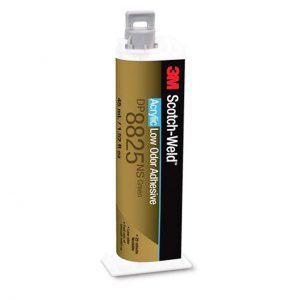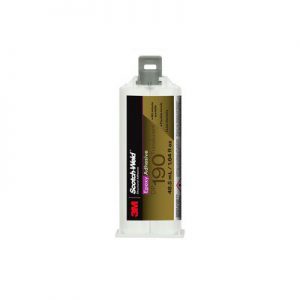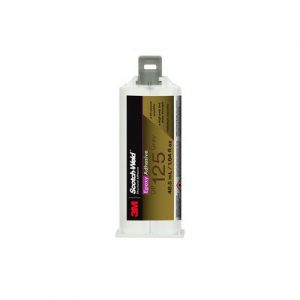3M DP8010 2-component structural adhesive
3M™ DP8010 Structural Adhesive is a two-part acrylic adhesive (10:1 mix ratio by volume) capable of bonding many low surface energy (LSE) plastics, including various grades of Polypropylene, Polyethylene, and TPO, without the need for special surface preparation. This adhesive can replace screws, rivets, plastic welding, and two-step processes involving chemical etchants, primers, or surface treatments in many applications.
- Ability to structurally bond polyolefins without special surface preparation.
- Ability to bond dissimilar substrates.
- Available in standard and non-sag formulations.
- Cures at room temperature.
- Excellent water and humidity resistance.
- Very good chemical resistance.
- One-step process; no pre-treatment of polyolefin substrates required.
- Solvent-free adhesive system.
- Convenient to use with a handheld applicator.
3M™ Scotch-Weld™ DP8010 Blue Structural Plastic Adhesive is a two-part acrylic adhesive specifically designed to bond a wide range of low surface energy (LSE) plastics, including various types of polypropylene, polyethylene, and thermoplastic elastomers (TPEs), without the need for special surface preparation.
Key Features:
- Creates strong bonds on low surface energy (LSE) plastics like polyolefins with minimal or no surface preparation.
- Medium viscosity allows for good control during application.
- Resistant to various chemicals, water, humidity, and corrosion.
- Formulated to bond a wide range of material assemblies, including LSE plastics, thermoplastics, composites, and metals.
| Attribute Name | Test Method | Temperature | Value |
|---|---|---|---|
| Base Color | Off-White | ||
| Accelerator Color | Blue | ||
| Base Density | 8.5 lb/gal | ||
| Accelerator Density | 8.3 — 8.7 lb/gal | ||
| Base Viscosity | 3M C1d | 27 °C (80 °F) | 27,000 cP |
| Accelerator Viscosity | 3M C1d | 27 °C (80 °F) | 17,000 — 40,000 cP |
| Attribute Name | Temperature | Value |
|---|---|---|
| Skin Formation Time | 22 °C (72 °F) | 3 min (1) |
| Worklife | 22 °C (72 °F) | 8 min (2) |
| Open Time | 22 °C (72 °F) | 10 min (3) |
| Set Time (min) | 22 °C (72 °F) | 60 min (4) |
| Time to Full Cure | 22 °C (72 °F) | 24 h (5) |
| Dispense Viscosity | 22 °C (72 °F) | 25,000 cP |
(1) An open bead line will show some skinning in approximately 3 minutes. It is possible to bond parts with good strength if the parts are made within 10 minutes. Therefore, the adhesive has a 10 minute open time for making bonds.
(2) Maximum time that adhesive can remain in a static mixing nozzle and still be expelled without undue force on the applicator. Cure times are approximate and depend on adhesive temperature.
(3) Max time allowed after applying adhesive to a substrate before bond must be closed and fixed. Cure times approximate and depend on adhesive temperature. Hotmelts: The approx. bonding range of a 1/8″ bead of molten adhesive on a non-metallic surface.
(4) Minimum time required to achieve 50 psi of overlap shear strength. Cure times are approximate and depend on adhesive temperature.
(5) The cure time is defined as that time required for the adhesive to achieve a minimum of 80% of the ultimate strength as measured by aluminum-aluminum OLS.
| Attribute Name | Test Method | Temperature | Test Condition | Value |
|---|---|---|---|---|
| Modulus | ASTM D638 | 22 °C (72 °F) | 77,000 lb/in² | |
| Storage Modulus | 22 °C (72 °F) | DMA | 970 MPa | |
| Strain at Break | ASTM D638 | 22 °C (72 °F) | 90% | |
| Shore D Hardness | ASTM D2240 | 22 °C (72 °F) | 57 |
Substrate: Polypropylene (PP) Temperature: 49 °C (120 °F) Dwell Time: 72 h
| Attribute Name | Test Method | Value |
|---|---|---|
| 180° Peel Adhesion | ASTM D3330 | Substrate Failure oz/in |
| Substrate | Surface Prep | Value |
|---|---|---|
| Aluminum | MEK/Abrade/MEK | 1960 lb/in² (CF) |
| Cold Rolled Steel | MEK/Abrade/MEK | 1800 lb/in² (CF) |
| Stainless Steel | MEK/Abrade/MEK | 1820 lb/in² (CF) |
| Galvanized Steel | MEK/Abrade/MEK | 1330 lb/in² (CF) |
| Copper | MEK/Abrade/MEK | 1870 lb/in² (CF) |
| Polycarbonate (PC) | IPA Wipe/Abrade/IPA Wipe | 1150 lb/in² (SF) |
| Low Density Polyethylene (LDPE) | IPA Wipe | 360 lb/in² (SF) |
| UHMWPE | IPA Wipe | 770 lb/in² (CF) |
For more information please check Datasheet
Directions for Use
1. To obtain the highest strength structural bonds, paint, oxide films, oils, dust, mold release agents, and all other surface contaminants must be completely removed. The amount of surface preparation depends on the required bond strength and environmental aging resistance desired by user. For suggested surface preparations on common substrates, see the section on surface preparation.
2. Mixing
For Duo-Pak Cartridges
Store cartridges with cap end up to allow any air bubbles to rise towards the tip. To use, simply insert the cartridge into the EPX applicator and start the plunger into the cylinders using light pressure on the trigger. Then remove the cap and expel a small amount of adhesive to ensure material flows freely from both sides of cartridge. For automatic mixing, attach an EPX mixing nozzle to the cartridge and begin dispensing the adhesive. For hand mixing, expel the desired amount of adhesive and mix thoroughly. Mix approximately 15 seconds after obtaining a uniform color.
Mix thoroughly by weight or volume in the proportion specified on the product label or in the typical uncured properties section. Mix approximately 15 seconds after obtaining a uniform color.
3. Apply adhesive and join surfaces within the open time listed for the specific product. Larger quantities and/or higher temperatures will reduce this working time.
4. Allow adhesive to cure at 60°F (16°C) or above until completely firm. Applying heat up to 150°F (66°C) will increase cure speed.
5. Keep parts from moving during cure. Apply contact pressure or fixture in place if necessary. Optimum bond line thickness ranges from 0.005 to 0.020 inch; shear strength will be maximized with thinner bond lines, while peel strength reaches a maximum with thicker bond lines.
6. Excess uncured adhesive can be cleaned up with ketone type solvents.
*Note: When using solvents, extinguish all ignition sources, including pilot lights, and follow the manufacturer’s precautions and directions for use.





